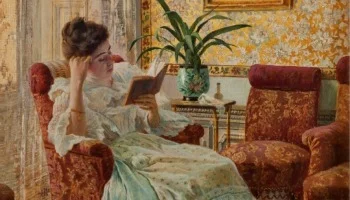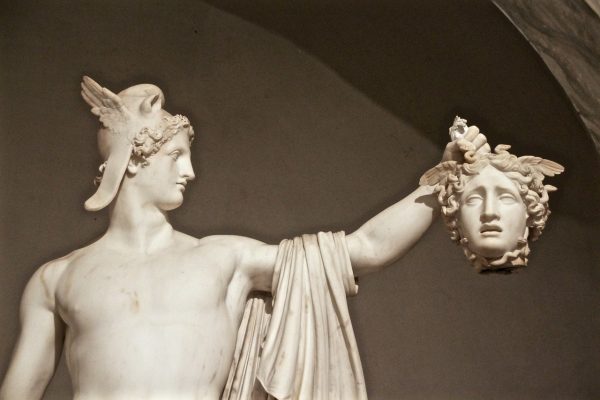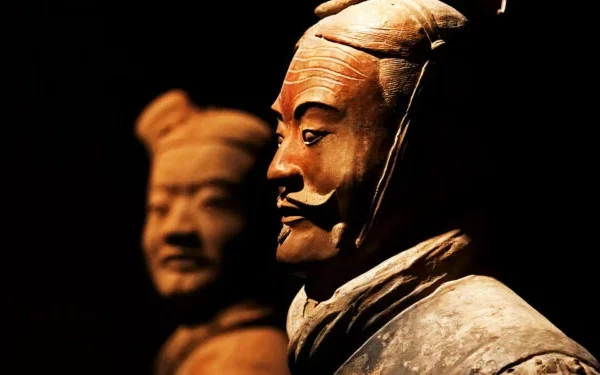Literary Movements
Literary movements refer to the trends in literature that share stylistic features, themes, aesthetics, and ideologies specific to certain periods in history. They don’t necessarily form a school but express the spirit of an era.
Talking about literary movements also includes literary trends, and oftentimes, the terms are used interchangeably. Some reserve the term “literary movements” to refer only to artists organized around a manifesto. Such movements can coexist with others but still constitute a literary current.
Classical Literature
By classical literature, reference is made to Greek and Roman literature from the so-called Classical Antiquity, i.e., Greco-Latin literature that developed from the 10th century BC to approximately the 3rd century AD. Greek literature was characterized by tales of mythological heroes, human exploits, and the development of genres like epic poetry, lyric poetry, and theater (tragedy and comedy). Some of its important authors and works were:
- Homer: The Iliad
- Sappho: Ode to Aphrodite
- Pindar: Olympian Odes
- Sophocles: Oedipus Rex
- Aristophanes: The Frogs
Latin literature was open to the influence of Greek culture. However, it formed its own characteristics, marked by greater pragmatism. Besides the known genres, it also developed fables, satire, and epigram. Examples of important authors and works include:
- Virgil: The Aeneid
- Ovid: Metamorphoses
- Horace: Odes
Medieval Literature
Medieval literature flourished between the 10th and 14th centuries approximately. It was dominated by religious thought, chivalric ideals, honor, and courtly love. It encompasses a wide diversity of expressions and trends, including prose, troubadour poetry, tales, chivalric novels, sentimental novels, religious dramas, and pre-humanist theater, among other genres. For instance:
“As Aristotle said—and it’s true—
man works for two things: the first,
for sustenance; and the other thing,
to unite with a pleasurable female.”
Arcipreste de Hita, Book of Good Love
Important works include:
- The Song of My Cid, anonymous
- Juan Ruiz, Arcipreste de Hita, Book of Good Love
- The Song of Roland, anonymous
- Nibelungenlied, anonymous
- Geoffrey Chaucer: The Canterbury Tales
- Dante Alighieri: The Divine Comedy
- Francisco Petrarca: Canzoniere
- Giovanni Boccaccio: Decameron
Renaissance Humanism
Renaissance literature, developed between the mid-14th and mid-16th centuries, was dominated by anthropocentric humanism, whose roots trace back to the Late Middle Ages, promoting Christian humanism. Renaissance humanism focused on human beings, exalted free will, and revived the study of Greco-Latin classics. This change in perspective transformed literature and gave rise to new literary genres like essays. For instance:
“So, reader, know that I myself am the content of my book, which is no reason for you to waste your time on such a frivolous and trifling matter. Farewell, then.”
Michel de Montaigne: “To the Reader,” Essays
Prominent authors included:
- Erasmus of Rotterdam, In Praise of Folly
- Thomas More, Utopia
- Michel de Montaigne, Essays
- Ludovico Ariosto, Orlando Furioso
- François Rabelais, Gargantua and Pantagruel
- Luís de Camões, The Lusiads
- William Shakespeare, Romeo and Juliet
To delve deeper, explore the Renaissance.
Spanish Golden Age
The Spanish Golden Age refers to the period of literary flourishing in Spain, which gained momentum in 1492 with the publication of the Spanish Grammar by Antonio de Nebrija and waned in the mid-17th century. It emerged at the end of the Renaissance and reached its full maturity in the first half of the Baroque period. It was during the Spanish Golden Age that Miguel de Cervantes wrote Don Quixote, representing the last chivalric novel and the first modern novel.
“His mind filled with everything he had read in books—stories of chivalry, duels, battles, challenges, wounds, wooings, storms, and impossible absurdities; and he set his heart upon regaining his reason, making himself the knight he had read about…”
Miguel de Cervantes, Don Quixote
During the Baroque, the Spanish Golden Age gave rise to two literary currents in Spain: conceptismo and culteranismo (or gongorismo, named after its foremost exponent, Luis de Góngora). Culteranismo emphasized forms, excessively using rhetorical figures and literary references. Conceptismo focused on presenting concepts through literary wit.
Notable authors and works include:
- Miguel de Cervantes, Don Quixote
- Francisco de Quevedo, The Life of the Buscón
- Tirso de Molina, The Trickster of Seville
- Lope de Vega, Fuenteovejuna
- Luis de Góngora, The Fable of Polyphemus and Galatea
- Pedro Calderón de la Barca, Life Is a Dream
Baroque Literature
Baroque literature emerged from the late 16th century and lasted until the early 18
th century, encompassing most of the Spanish Golden Age. It discarded the confident outlook of humanism and adopted a more disenchanted perspective on life. It sought discursive beauty through formal exuberance and attention to detail.
“In pursuing me, world, what do you gain?
How do I offend you when all I aim for
is to set beauties in my understanding,
not my understanding on the beautiful?”
Sor Juana Inés de la Cruz, “In Pursuing Me, World, What Do You Gain?”
Besides writers from the Spanish Golden Age like Góngora, Lope de Vega, or Quevedo, other representative authors of the Baroque include:
- Jean Racine, Phaedra
- John Milton, Paradise Lost
- Sor Juana Inés de la Cruz, Divine Narcissus
Neoclassicism
The aesthetic expression of the Enlightenment is known as neoclassicism, developing in the 18th century as a reaction to the baroque aesthetic. It proposed a return to reason, rejecting emotionality and showiness. Critical and narrative genres predominated, favoring discourse elegance and focusing on the conflict between duty, honor, and passions. Poetry was not its most outstanding genre.
“Awaken, my dear Bolingbroke; leave all the trivialities to base ambition and pride of the powerful. For all we can get from this life comes down to seeing clearly around ourselves, and then dying. Let us at least freely roam this man’s scene—astonishing labyrinth!—which has its certain regularity… Come, join me; let us explore this vast field, whether it be flat or mountainous, let’s see what’s in it.”
Alexander Pope, philosophical poem “Essay on Man”
Some of the notable authors and works in neoclassical literature are:
- Daniel Defoe, Robinson Crusoe
- Jonathan Swift, Gulliver’s Travels
- Alexander Pope, Essay on Man, philosophical poem
- Jean-Jacques Rousseau, Emile or On Education
- Voltaire, Candide or Optimism
- Jean de La Fontaine, Fables
- Carlo Goldoni, The Mistress of the Inn
- Montesquieu, The Spirit of the Laws
Romanticism
Romantic literature originated from the German Sturm und Drang movement in the late 18th century and extended to the early decades of the 19th century. It allowed for revolutionary development in national literatures, incorporating popular subjects and genres, exalting subjectivity, freeing poetry from neoclassical canons, and stimulating new narrative genres like the gothic and historical novels.
“Wilhem, what would the world be to our hearts without love? A magic lantern without light. Barely do you light the lamp and all those colors appear on your white wall. And even if they were just that, fleeting phantoms, they constitute our happiness if we see them as little children and marvel at those wonderful appearances.”
Goethe, The Sorrows of Young Werther
Some of its important authors and works include:
- Johann Wolfgang von Goethe, The Sorrows of Young Werther
- Novalis, Spiritual Songs
- Lord Byron, Don Juan
- John Keats, Ode on a Grecian Urn
- Victor Hugo, Les Misérables
- Alexandre Dumas, The Count of Monte Cristo
- José de Espronceda, El Estudiante de Salamanca
- Gustavo Adolfo Bécquer, Rimas y Leyendas
- Jorge Isaacs, María
Realism
Realism emerged as a reaction against Romanticism, which it considered overly sentimental. It began in the mid-19th century and lasted for several decades. It focused on social reality and aimed to represent it objectively and critically.
“Was this miserable life to be eternal? Was she never to escape it? Was she not worth as much as those who were happy?”
Gustave Flaubert, Madame Bovary
Some of the significant authors and works include:
- Stendhal, The Red and the Black
- Honoré de Balzac, Eugénie Grandet
- Gustave Flaubert, Madame Bovary
- Charles Dickens, Oliver Twist
- Mark Twain, The Adventures of Tom Sawyer
- Fyodor Dostoevsky, Crime and Punishment
- Leo Tolstoy, Anna Karenina
- Anton Chekhov, The Cherry Orchard
- Benito Pérez Galdós, Fortunata and Jacinta
- Eça de Queirós, The Crime of Father Amaro
Naturalism
Naturalism emerged in the latter half of the 19th century and was heavily influenced by determinism, experimental science, and materialism. It also focused on social reality but aimed to portray it without personal judgment.
“This dream of the physiologist and the experimenting doctor is also the dream of the novelist who applies the experimental method to the natural and social study of man. Our goal is theirs: we want to control intellectual and personal phenomena to direct them. We are, in a word, experimental moralists who demonstrate through experience how a passion behaves in a social environment.”
Emile Zola, The Experimental Novel
Prominent authors include:
- Emile Zola, Nana
- Guy de Maupassant, Boule de Suif
- Thomas Hardy, Tess of the d’Urbervilles
Costumbrismo
Costumbrismo was a 19th-century movement rooted in nationalism and aimed to depict the customs and traditions of countries or regions objectively. It often carried a touch of picturesque quality. The costumbrista novel was its pinnacle.
“Among all those rascals, not a sign of a shoe or a complete shirt; all six of them were barefoot, and half of them had no shirts.”
José María Pereda, Sotileza
Important authors and works include:
- José María de Pereda, Sotileza
- Juan Valera, Pepita
- Fernán Caballero, The Seagull
- Ricardo Palma, Peruvian Traditions



